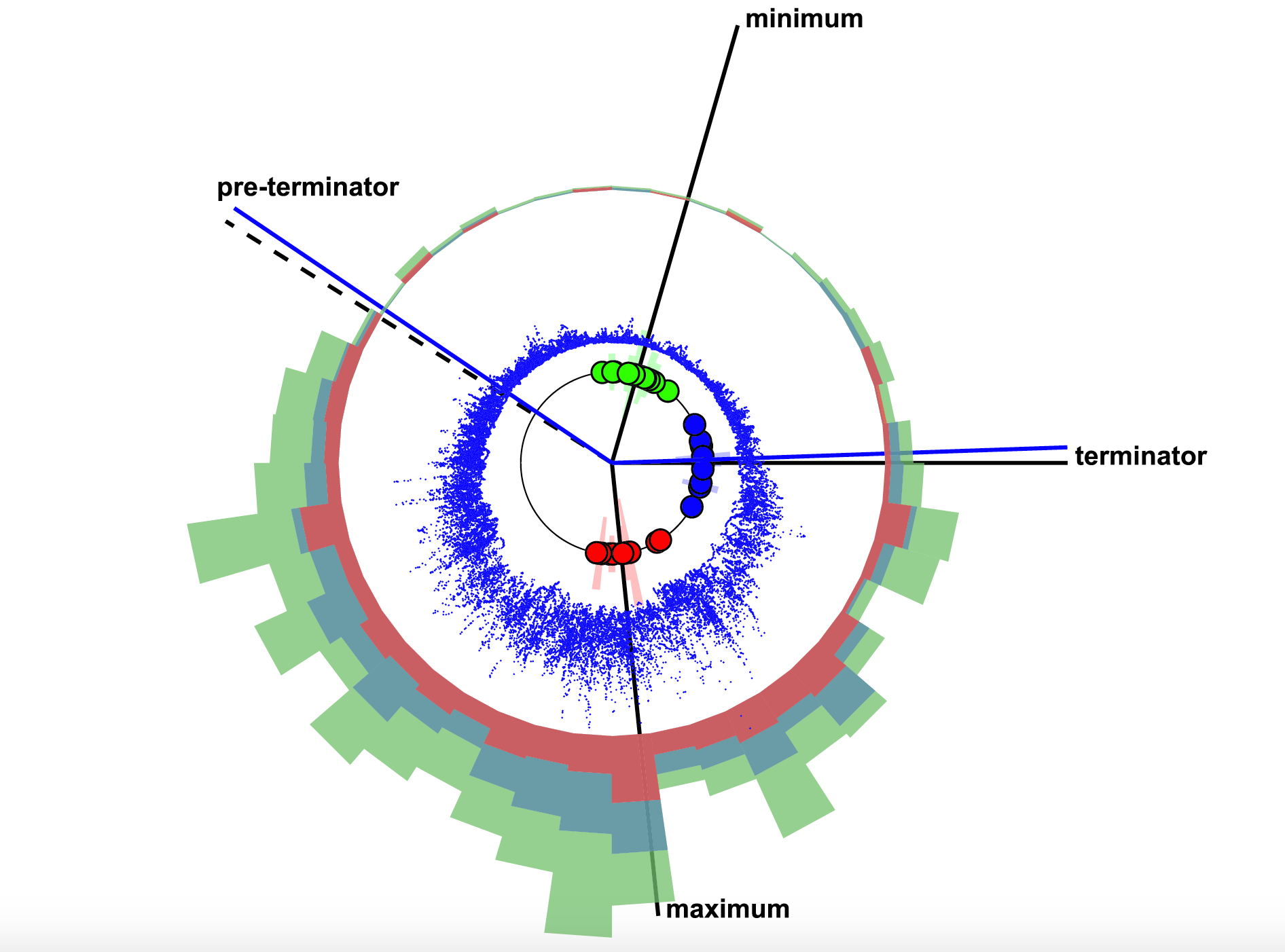New ‘Sun clock’ reveals that solar activity turns off and on with surprising precision
Clock paints picture of a more orderly, predictable Sun
Jun 10, 2020 - by Laura Snider
Jun 10, 2020 - by Laura Snider

The Sun clock constructed by the research team. The maxima and minima of the last 18 solar cycles are indicated by red and green circles, respectively, and the blue circles indicate terminators for the last 12 solar cycles. Black lines indicate the maxima, minima, and terminators. (Image: Scott McIntosh, NCAR)
Solar scientists have taken a mathematical technique used by Earth scientists to analyze cyclic phenomena, such as the ebb and flow of ocean tides, and applied it to the confounding irregularity of cycles on the Sun. The result is an elegant “Sun clock” that shows that solar activity starts and stops on a much more precise schedule than could be discerned when looking at observations of the Sun in the traditional way – plotted linearly over time.
The new research, published in the journal Geophysical Research Letters, was led by the University of Warwick in England and involved researchers from the National Center for Atmospheric Research (NCAR) and NASA.
Solar cycles – marked by the rhythmic waxing and waning of activity on the Sun – occur every 11 years on average, but they can last years longer or shorter. They also vary in their strength. While they all build from a quiet start toward the cycle’s solar maximum before quieting again, the magnitude of that maximum can change significantly from cycle to cycle. During and after solar maximum, the Sun is more likely to produce space weather that can impact Earth, damaging satellites, scrambling radio communications, and disrupting power grids, among other impacts. The new sun clock could be used as a planning tool to help keep space- and ground-based infrastructure safe.
The clock was created using a technique known as the Hilbert transform to convert the linear observations of past solar cycles onto a circle, stretching and shrinking the cycles as necessary to a standard 11 years. As the cycles were overlaid on top of each other on the clock’s face, distinct “times” on the clock face when solar activity is flipped on and off came into focus.
“Scientists spend their lives trying to read the book of nature,” said Sandra Chapman, a professor at the University of Warwick who led the study. “Sometimes we create a new way to transform the data, and what appeared to be messy and complicated is suddenly beautifully simple. In this instance, our Sun clock method showed clear switch on and switch off times demarcating quiet and active intervals for space weather for the first time.”
The idea of applying a Hilbert transform to sunspot data was born out of a chance meeting at a conference in 2018, when Chapman, a plasma physicist, suggested that co-author Robert Leamon, a NASA scientist, apply the transform to help make sense of another project he was working on that involved the cyclic nature of El Niño.
“The Hilbert transform is a really powerful technique across all of science," said Leamon, also of the University of Maryland. "When we applied it to sunspots, we saw it tied to the sharp switch-on of activity that we'd seen elsewhere. Further analysis of the geomagnetic data revealed the switch off as well."
The creation of the solar clock is part of a larger body of research that makes a case that the Sun’s cycles are far more predictable and regular than scientists realize. For example, Leamon and study co-author Scott McIntosh, NCAR deputy director, have identified “terminator” events on the Sun, which they say offer observational evidence of the start and stop of solar cycles, something that has been estimated in the past.
“The Sun is not nearly as irregular as we thought,” McIntosh said. “But we’ve been looking in the wrong places. Once you realize that the Sun is actually adhering to a larger cycle, and that the appearance and disappearance of sunspots are just a symptom of that cycle, not the cycle itself, you see a beautiful order in the chaos. The striking regularity we find in this new sun clock is evidence of that.”
Read more about the study at the University of Warwick.